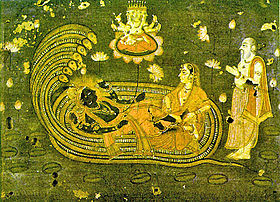Shayani Ekadashi
| Shayani Ekadashi | |
|---|---|
 Vishnu sleeps on the Shesha Shaiya | |
| Official name | Deva-Shayani Ashadi Ekadashi |
| Also called | Maha-Ekadashi |
| Observed by | Hindus, especially Vaishnavas |
| Type | Hindu |
| Significance | Beginning of the chaturmas |
| Observances | Prayers and religious rituals, including puja to Vishnu; Pandharpur Yatra |
| Frequency | Annual |
| Related to | Prabodhini Ekadashi |
Shayani Ekadashi ("sleeping eleventh"), also known as Maha-ekadashi ("The great eleventh"), is the eleventh lunar day (Ekadashi) of the bright fortnight (Shukla paksha) of the Hindu month of Ashadha (June - July). This holy day is of special significance to Vaishnavas, followers of the Hindu protector God, Lord Vishnu.[3]
Beliefs[edit]
On this day images of Vishnu and Lakshmi are worshipped,[4] the night is spent singing prayers, and devotees fast and take vows on this day, to be observed during the entire chaturmas, the holy four-month period of rainy season. These may include, giving up a food item or fasting on every Ekadashi day.[citation needed]
It is believed that Vishnu falls asleep in Ksheersagar - cosmic ocean of milk - on Shesha nāga, the cosmic serpent.[5] Thus the day is also called Dev-Shayani Ekadashi (lit. "god-sleeping eleventh") or Hari-shayani Ekadashi (lit. "Vishnu-sleeping eleventh") or Shayana Ekadashi. Vishnu finally awakens from his slumber four months later on Prabodhini Ekadashi - eleventh day of bright fortnight in the Hindu month Kartik (October–November). This period is known as Chaturmas (lit. "four months") and coincides with the rainy season. Shayani Ekadashi is the beginning of Chaturmas. Devotees start observing the Chaturmas vrata (vow) to please Vishnu on this day.[6]
A fast is observed on Shayani Ekadashi. The fast demands abstinence from all grains, beans, and cereals, as well as certain vegetables including onions and certain spices.
Significance[edit]
In Bhavishyottara Purana, Krishna narrates significance of Shayani Ekadashi to Yudhishthira, as the creator-god Brahma narrated the significance to his son Narada once. The story of King Mandata is narrated in this context. The pious king's country had faced drought for three years, but the king was unable to find a solution to please the rain gods. Eventually, sage Angiras advised the king to observe the vrata (vow) of Dev-shayani ekadashi. On doing so by the grace of Vishnu, there was rain in the kingdom.[6]
Pandharpur Yatra[edit]

This day, a huge yatra or religious procession of pilgrims known as Pandharpur Ashadi Ekadasi Waari Yatra culminates at Pandharpur, in Solapur district in south Maharashtra, situated on the banks of the Chandrabhaga River. Pandharpur is main center of worship of the deity Vitthal, a local form of Vishnu. Lakhs (hundreds of thousands) of pilgrims come to Pandharpur on this day from different parts of Maharashtra. Some of them carry Palkhis (palanquins) with the images of the saints of Maharashtra. Dnyaneshwar's image is carried from Alandi, Namdev's image from Narsi Namdev, Tukaram's from Dehu, Eknath's from Paithan, Nivruttinath's from Trimbakeshwar, Muktabai's from Muktainagar, Sopan's from Sasvad and Saint Gajanan Maharaj from Shegaon. These pilgrims are referred to as Warkaris. They sing Abhangas (chanting hymns) of Saint Tukaram and Saint Dnyaneshwar, dedicated to Vitthal.
References[edit]
- ↑ http://www.festivalsofindia.in/Devshayani-Ekadashi/Index.aspx
- ↑ About Devshayani Ekadashi
- ↑ List of All Ekadashi: https://www.bhaktibharat.com/festival/ekadashi
- ↑ "Devshayani Ekadashi 2021: देवशयनी एकादशी | विष्णु जी की वास्तविक साधना". S A NEWS. 2021-07-20. Retrieved 2021-07-21.
- ↑ Fasts and Festivals of India (2002) By Manish Verma. Diamond Pocket Books (P) Ltd. ISBN 81-7182-076-X. p.33
- ↑ 6.0 6.1 Shayana Ekadashi Archived 2009-03-04 at the Wayback Machine ISKCON
